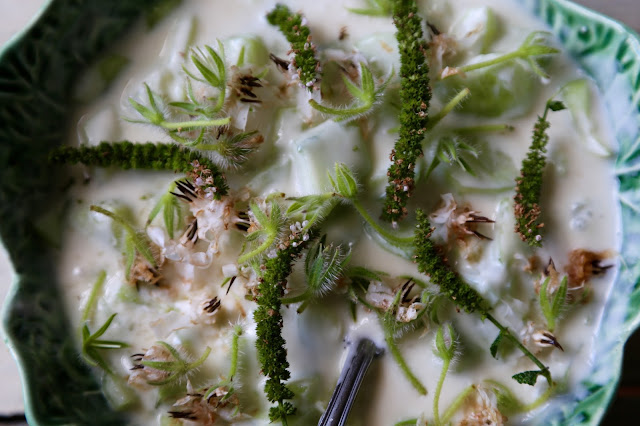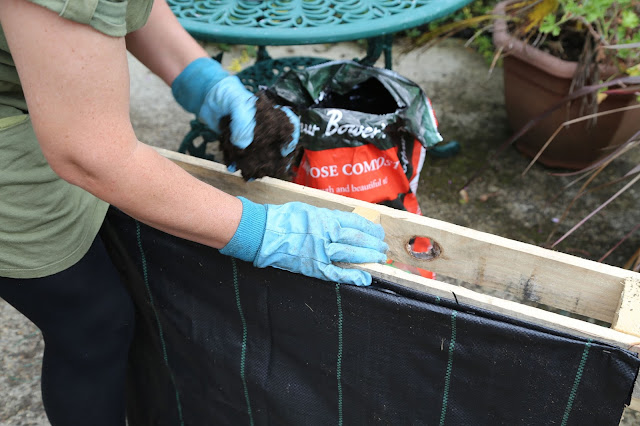Gardening books
The New Kitchen Garden by Mark Diacono £18.80
I've been an admirer of Mark's work for some time and here is his award winning kitchen garden book. Like us, he wants to make the best use of his garden space (even though he has a great deal more) and grow unusual interesting plants. He thinks like a cook as well as a gardener.
Fern Verrow, a year of recipes from a farm and its kitchen by Jane Scotter and Harry Astley and photographs by Tessa Traegar (Quadrille) £19.99
Fern Verrow is a biodynamic farm near Haye on Wye owned by Scotter and Astley and this book is their story. Like the Secret Garden Club, the emphasis is equally upon growing and good food, with interesting seasonal recipes throughout structured around the elements. Tessa Traegar's pioneering nature, landscape and food photography is superb. A beautiful gift.
Heirloom Harvest by Amy Goldman and Jerry Spagnoli (Bloomsbury 2015) £26
Shot in stark architectural black and white, these art house daguerrotypes by Spagnoli are reminiscent of the work of photographic pioneer Edward Steichen. The book consists of nude vegetables and fruit, almost sexy. The text by Goldman explores growing heirloom seeds. This book is for lovers of good photography, gardening and vegetables.
RHS Grow for Flavour by James Wong (Mitchell Beazley) £10
A truly fantastic book, reviewed earlier this year by my colleague Zia Mays.
Norwegian Wood: Chopping, Stacking and Drying Wood the Scandinavian Way by Lars Matting (MacLeHose Press) £13.60
This book has been a surprise hit in the best seller lists. Did I ever mention that I used to go out with a cross-dressing French lumberjack? He used to smell of bonfire (which I find a big turn on, I have quite basic tastes when it comes to men) and live in a squat in London Fields swimming pool along with myself, my daughter and the street artist Stik. They had no heating there and the only person that could really cope with the condition was my boyfriend who spent all year preparing for winter. Outside his room, which was a changing room, he had months of beautifully stacked and dried wood. He found wood chopping therapeutic and taught myself and my daughter how to use an axe.

The Ladybird Book of the Shed (Ladybird books for grownups) by Hazeley and Morris (Michael Joseph) £5.24
This would make an amusing stocking filler. I love a shed, I've got a she-shed at the bottom of my garden.
Yuzu plant £40
I've had a go at planting citrus before but everything died. I wondered if I kept it in the wrong place. Plants4presents are now stocking yuzu fruit plants at £40 plus delivery which is a gorgeous citrus that has an almost indescribably floral taste. I'm going to try again, this time keeping it in the living room. Fingers crossed.

Kaffir lime plant £25
The great thing about this plant is that even if you don't get any fruit, you can use the gorgeous fresh lime leaves in your cooking. Check out my Thai Green curry recipe here. I also keep lime leaves in the freezer. The kaffir lime plant is available from Plants4Presents.
Plant wasabi £7.50
Genuine wasabi is different to horseradish. You can easily grow it in the UK. Order your plant from The Wasabi Company.
Plantable wrapping paper £4.99
You can get it with all kinds of vegetables such as broccoli, peppers, onions, tomatoes. Such a fun idea.

Plantable paper shapes £14.99
A similar principle to above but these would be so pretty as tags for presents wouldnt' they? The paper is impregnated with seeds such as herbs or poppy seeds. 25 in the pack.
Copper Gardening Tools £32
Copper is a very special material. When alloyed with tin it becomes bronze. It's antimicrobial, non magnetic and repellent to slugs and snails. This trowel from Alchemade is pricey at almost £100 but much cheaper in the States. A cheaper version in the UK(seen above) is from Implementations at £32.
Sophie Conran Gardener's Gubbins £15.99
A zinc organiser for all the gardener's bits and bobs. Sort of retro French in style, shabby chic gardening.
A Big Green Egg BBQ from £399 up to £4k
The ultimate BBQ, the design means you can build up a long slow burn, meaning your food is succulent and juicy. You can use it as a smoker in the winter.
Local lumpwood charcoal £8 a bag
For that BBQ you want local sustainably sourced charcoal, most of the UK's charcoal is from overseas, isn't as good. My local guy is Iain Loasby of Rivenwood Coppice. You can also buy biochar from Iain which is a great way to put minerals back into the soil. We will be experimenting with this in the Secret Garden Club. Find out more about biochar here. You can find your local coppicer, firewood supplier and charcoal maker here.
A Secret Garden Club e-voucher £40
Buy a Secret Garden Club workshop and supper, £40 a head, redeemable for any event. Just email me at marmitelover@mac.com
Don't forget our Grow Your Own Curry supper club is on this Sunday afternoon. Buy tickets here: http://www.edibleexperiences.com/p/69/The-Underground-Restaurant/770001/Secret-Garden-Club-grow-your-own-curry £40
The New Kitchen Garden by Mark Diacono £18.80
I've been an admirer of Mark's work for some time and here is his award winning kitchen garden book. Like us, he wants to make the best use of his garden space (even though he has a great deal more) and grow unusual interesting plants. He thinks like a cook as well as a gardener.
Fern Verrow, a year of recipes from a farm and its kitchen by Jane Scotter and Harry Astley and photographs by Tessa Traegar (Quadrille) £19.99
Fern Verrow is a biodynamic farm near Haye on Wye owned by Scotter and Astley and this book is their story. Like the Secret Garden Club, the emphasis is equally upon growing and good food, with interesting seasonal recipes throughout structured around the elements. Tessa Traegar's pioneering nature, landscape and food photography is superb. A beautiful gift.
Heirloom Harvest by Amy Goldman and Jerry Spagnoli (Bloomsbury 2015) £26
Shot in stark architectural black and white, these art house daguerrotypes by Spagnoli are reminiscent of the work of photographic pioneer Edward Steichen. The book consists of nude vegetables and fruit, almost sexy. The text by Goldman explores growing heirloom seeds. This book is for lovers of good photography, gardening and vegetables.
RHS Grow for Flavour by James Wong (Mitchell Beazley) £10
A truly fantastic book, reviewed earlier this year by my colleague Zia Mays.
Norwegian Wood: Chopping, Stacking and Drying Wood the Scandinavian Way by Lars Matting (MacLeHose Press) £13.60
This book has been a surprise hit in the best seller lists. Did I ever mention that I used to go out with a cross-dressing French lumberjack? He used to smell of bonfire (which I find a big turn on, I have quite basic tastes when it comes to men) and live in a squat in London Fields swimming pool along with myself, my daughter and the street artist Stik. They had no heating there and the only person that could really cope with the condition was my boyfriend who spent all year preparing for winter. Outside his room, which was a changing room, he had months of beautifully stacked and dried wood. He found wood chopping therapeutic and taught myself and my daughter how to use an axe.

This would make an amusing stocking filler. I love a shed, I've got a she-shed at the bottom of my garden.
Plants:
Yuzu plant £40
I've had a go at planting citrus before but everything died. I wondered if I kept it in the wrong place. Plants4presents are now stocking yuzu fruit plants at £40 plus delivery which is a gorgeous citrus that has an almost indescribably floral taste. I'm going to try again, this time keeping it in the living room. Fingers crossed.

Kaffir lime plant £25
The great thing about this plant is that even if you don't get any fruit, you can use the gorgeous fresh lime leaves in your cooking. Check out my Thai Green curry recipe here. I also keep lime leaves in the freezer. The kaffir lime plant is available from Plants4Presents.
Plant wasabi £7.50
Genuine wasabi is different to horseradish. You can easily grow it in the UK. Order your plant from The Wasabi Company.
You can get it with all kinds of vegetables such as broccoli, peppers, onions, tomatoes. Such a fun idea.

Plantable paper shapes £14.99
A similar principle to above but these would be so pretty as tags for presents wouldnt' they? The paper is impregnated with seeds such as herbs or poppy seeds. 25 in the pack.
Copper Gardening Tools £32
Copper is a very special material. When alloyed with tin it becomes bronze. It's antimicrobial, non magnetic and repellent to slugs and snails. This trowel from Alchemade is pricey at almost £100 but much cheaper in the States. A cheaper version in the UK(seen above) is from Implementations at £32.
Sophie Conran Gardener's Gubbins £15.99
A zinc organiser for all the gardener's bits and bobs. Sort of retro French in style, shabby chic gardening.
A Big Green Egg BBQ from £399 up to £4k
The ultimate BBQ, the design means you can build up a long slow burn, meaning your food is succulent and juicy. You can use it as a smoker in the winter.
Local lumpwood charcoal £8 a bag
For that BBQ you want local sustainably sourced charcoal, most of the UK's charcoal is from overseas, isn't as good. My local guy is Iain Loasby of Rivenwood Coppice. You can also buy biochar from Iain which is a great way to put minerals back into the soil. We will be experimenting with this in the Secret Garden Club. Find out more about biochar here. You can find your local coppicer, firewood supplier and charcoal maker here.
A Secret Garden Club e-voucher £40
Buy a Secret Garden Club workshop and supper, £40 a head, redeemable for any event. Just email me at marmitelover@mac.com
Don't forget our Grow Your Own Curry supper club is on this Sunday afternoon. Buy tickets here: http://www.edibleexperiences.com/p/69/The-Underground-Restaurant/770001/Secret-Garden-Club-grow-your-own-curry £40
















































